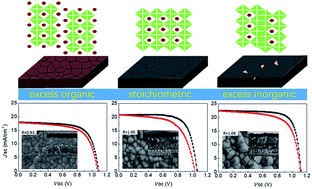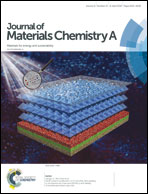Organic/inorganic self-doping controlled crystallization and electronic properties of mixed perovskite solar cells†
Abstract
Organic and inorganic molecules/atoms located at different lattice positions in hybrid perovskite films play various roles in crystallization and carrier transport for perovskite films. For efficient and stable solar devices, high quality crystals and the proper dispersion of organic/inorganic species are required. In a preferably mixed perovskite system (a blend of MA, FA, I, Br, etc.), however, the effects of inorganic/organic ratios on the performances and electrical properties of perovskite solar cells have not been fully understood. Here, we present perovskite solar cells with self-doped organic and inorganic components to investigate in detail their effect on crystallization and electrical properties. The organic component enhances the conductivity and reduces the hysteresis, while the inorganic component promotes crystal growth. A critical composition is beneficial to perovskite crystallization, with larger crystals and a pinhole-free morphology, and the corresponding device achieved a high efficiency over 19.14% (0.16 cm2, mask area) and 16.2% at an area of 1.21 cm2. Thus, evaluation of the organic/inorganic variation effects provides an understanding of self-doping in mixed perovskites and is beneficial to pursue high-performance perovskite devices.



 Please wait while we load your content...
Please wait while we load your content...